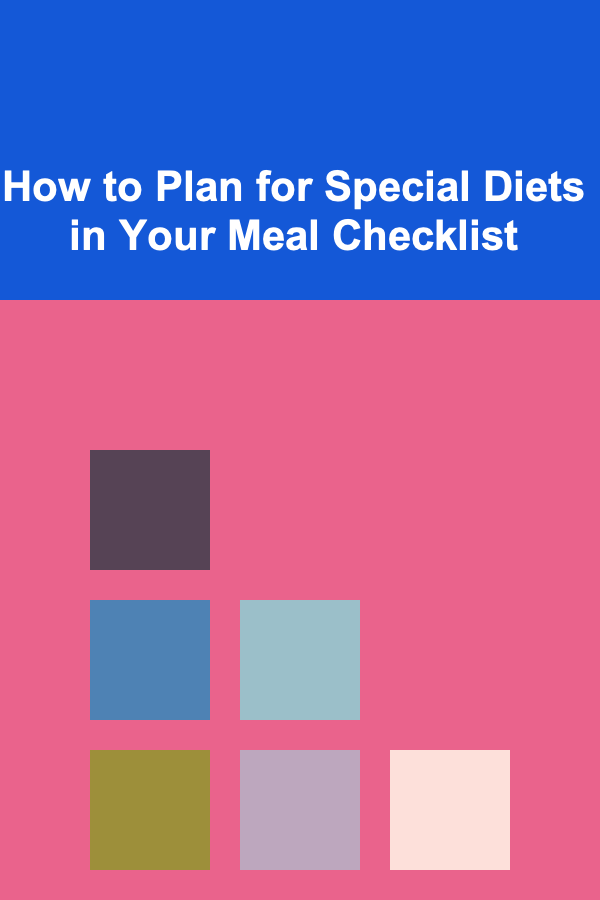
How to Plan for Special Diets in Your Meal Checklist
ebook include PDF & Audio bundle (Micro Guide)
$12.99$9.99
Limited Time Offer! Order within the next:

When planning meals for a group, whether it's for a family gathering, a work event, or even a wedding reception, it's essential to consider dietary restrictions and preferences. Special diets can be complex, encompassing everything from food allergies and intolerances to personal lifestyle choices like vegetarianism or veganism. Failing to plan for these needs can result in awkward situations, dissatisfaction, or even health risks for those affected.
In this actionable guide, we'll explore how to plan for special diets in your meal checklist, ensuring that everyone is accommodated and can enjoy their meal. By understanding the different types of special diets, how to manage them effectively, and the tools to incorporate them into your meal plan, you'll be able to create an inclusive and thoughtful menu for any event.
Step 1: Identify and Understand Special Diets
Before you start planning, it's crucial to know what types of special diets exist and which ones might be relevant for your event. Special diets generally fall into several broad categories:
1.1 Food Allergies and Intolerances
Food allergies and intolerances can be severe and even life-threatening, making them one of the most critical considerations in meal planning. Common food allergies include:
- Peanuts and Tree Nuts
- Dairy (Lactose Intolerance)
- Eggs
- Wheat (Gluten Intolerance or Celiac Disease)
- Fish and Shellfish
- Soy
In addition to allergies, some people may have intolerances to certain ingredients that cause discomfort rather than a severe allergic reaction. For example, lactose intolerance is common, and individuals with this condition should avoid dairy products.
1.2 Vegetarian and Vegan Diets
Vegetarianism and veganism are lifestyle choices that have grown significantly in popularity over the years. There are various types of vegetarian diets:
- Lacto-vegetarian: No meat or eggs but includes dairy products.
- Ovo-vegetarian: No meat or dairy but includes eggs.
- Pesco-vegetarian: Includes fish but avoids other meats.
A vegan diet is more restrictive than vegetarianism, excluding all animal products, including dairy, eggs, honey, and even gelatin.
1.3 Religious Diets
Religious beliefs often dictate dietary restrictions. Some common examples include:
- Halal (Islamic dietary laws): This involves avoiding pork and any form of alcohol and ensuring that meat is slaughtered in accordance with Islamic guidelines.
- Kosher (Jewish dietary laws): This includes avoiding pork and shellfish, ensuring meat is slaughtered according to Jewish law, and separating meat from dairy products.
1.4 Health Conditions
Certain health conditions also require special diets to manage symptoms. These may include:
- Diabetes: Individuals with diabetes may need to monitor carbohydrate intake and balance their meals to control blood sugar levels.
- Celiac Disease: People with celiac disease must follow a strict gluten-free diet to avoid damaging their intestines.
- Heart Disease or Hypertension: Low-sodium or low-fat diets may be necessary for those with heart-related health issues.
1.5 Low-Carb, Low-Fat, or Keto Diets
People who follow weight management or metabolic health strategies often prefer low-carb, low-fat, or ketogenic diets. These diets restrict certain macronutrients to encourage weight loss, energy regulation, or other health benefits.
Step 2: Collect Dietary Information From Attendees
Once you have an understanding of the types of special diets, the next step is to gather information from your guests. It's important to ask specific questions to ensure that you're accommodating everyone's needs. Here are some tips for collecting this information:
2.1 Send Out a Survey
For larger events, sending out a meal preference survey is an effective way to collect information. Make sure your survey includes questions about:
- Food allergies and intolerances
- Vegetarian, vegan, or other plant-based preferences
- Religious dietary restrictions
- Health-related dietary needs (e.g., diabetes, gluten-free)
- Personal preferences (e.g., preferences for low-carb or keto)
Be sure to leave an option for attendees to specify any other dietary restrictions you may not have thought of.
2.2 Use RSVP Forms
For smaller gatherings or more casual events, you can include dietary preference questions in your RSVP form. This ensures that the guest list is confirmed and their dietary needs are noted early on.
2.3 Clarify Ambiguities
Sometimes, dietary needs are not clearly communicated. For example, someone may indicate they are "vegetarian" but may eat fish or eggs. Make sure to follow up for clarification if you're unsure about any dietary preferences or restrictions.
Step 3: Create Your Meal Plan
Once you've gathered all the relevant dietary information, it's time to start planning your menu. A well-thought-out meal plan should be both inclusive and practical. Follow these steps:
3.1 Create a Balanced Menu
Make sure your menu includes a variety of options that cater to different dietary needs. Consider the following:
- Protein sources: Include plant-based proteins (e.g., tofu, tempeh, beans) alongside traditional meat options (e.g., chicken, beef, fish).
- Vegetables and grains: Include a wide variety of vegetables and whole grains to ensure all dietary preferences are satisfied. For gluten-free individuals, you can use quinoa, rice, or corn-based products.
- Dairy-free options: If you have guests with lactose intolerance, ensure you offer dairy-free options such as almond milk, soy cheese, or coconut yogurt.
3.2 Offer Modifiable Dishes
For flexibility, try to include dishes that can be easily modified to meet different dietary restrictions. For example, if you're serving pasta, provide a gluten-free option, and if you're serving salads, allow for toppings like nuts, cheese, and meats to be added or excluded based on individual preferences.
3.3 Consider Cross-Contamination
If your event involves both gluten-free and gluten-containing foods, make sure to prevent cross-contamination. Use separate utensils, chopping boards, and preparation spaces. Clearly label foods that may contain allergens to help guests make safe choices.
3.4 Provide Labels
Labeling your food items is essential, especially for large events where it's difficult to keep track of every individual's dietary restrictions. Consider including labels that specify whether the dish is gluten-free, vegan, nut-free, etc.
3.5 Ensure Variety
Ensure that your meal plan includes options for people with different preferences. Some guests may prefer raw foods, while others may want cooked meals. Offering a variety of textures and flavors ensures that no one feels left out.
Step 4: Prepare for the Event
Preparation is key when catering for special diets. These steps will help you ensure a smooth event:
4.1 Source the Right Ingredients
For those following specific diets, it's important to source the correct ingredients. Shop at specialty grocery stores or online retailers that offer organic, gluten-free, or vegan-friendly products. Don't forget to check ingredient labels carefully.
4.2 Hire a Professional (If Needed)
If you're hosting a large event and you feel overwhelmed by the complexity of special diets, consider hiring a catering service experienced in managing dietary restrictions. Professional caterers are typically well-versed in creating inclusive meals, and they can help ensure that everything is safe and well-prepared.
4.3 Communicate With the Kitchen Staff
If you're preparing the meals yourself, clearly communicate any dietary needs to the kitchen staff. Make sure they understand the importance of avoiding cross-contamination and are aware of which dishes cater to specific diets.
4.4 Keep Emergency Options On-Hand
If you're unsure about all of the dietary preferences and restrictions, it's a good idea to have some emergency, easy-to-make options available, such as salads, fruit, or simple snacks. This way, you're prepared if a guest has an unexpected dietary need or if an issue arises.
Step 5: During the Event
When the event is underway, ensure that the food is presented clearly and with respect for dietary restrictions. Here are some tips:
5.1 Ensure Clear Labeling
As mentioned earlier, labels are key to ensuring that guests can easily identify which dishes are suitable for them. Place labels in front of each dish and use color-coding if necessary to make it more obvious.
5.2 Provide Assistance
If necessary, have a staff member or volunteer available to help guests with questions about which foods are safe for them to eat. This can be especially useful for larger events or for guests who may be unfamiliar with the menu.
5.3 Stay Flexible
Dietary needs can change, and guests may arrive with last-minute requests. Stay flexible and be willing to accommodate new preferences if they arise. It's always better to have extra options than to leave someone without a meal that suits their needs.
Conclusion
Planning for special diets in your meal checklist can seem like a daunting task, but with thoughtful preparation and clear communication, it can be done successfully. By understanding the different types of dietary restrictions, gathering necessary information from your guests, and offering a variety of options, you can ensure that everyone at your event feels included and well-fed.
A little extra effort in meal planning not only makes your guests feel cared for but also ensures that everyone can enjoy the event to the fullest without concern about their dietary needs. By following these actionable steps, you'll create a memorable and inclusive dining experience for all.
Other Products

How to Clean and Maintain Your Home's Ventilation System
Read More
How to Create a Statement Lighting Fixture in Your Home
Read More
How to Digitize Physical Documents for Better Organization
Read More
How to Keep Your Home Clean with Pets and Kids Around
Read More
How to Manage Seasonal Pet Supplies Efficiently
Read More